A popular legend depicts the Augustinian monk Martin Luther nailing a parchment to the door of the Wittenberg Palace Church in 1517, his “ninety five theses” a direct challenge to the authority of the pope, and the Catholic church. It likely never happened that way. Luther had no intention of confronting the Church. Subsequent events would harden Luther’s attitudes toward the Church but for now, this was but ninety-five propositions, framed and submitted for scholarly disputation.
Luther enclosed his “ninety five theses” in a letter to the Archbishop of Mainz on October 31, the date now considered to be the beginning of the Protestant Reformation.
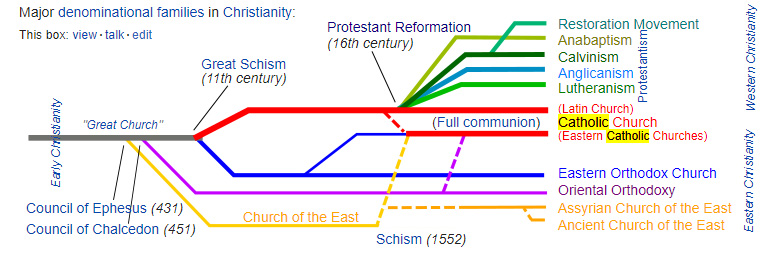
H/T Wikipedia
To the modern reader, theological issues such as the “moral bank account” of saints or the transubstantiation of the body and blood of Christ, may seem mere doctrinal interpretations. In the late middle and early modern ages, such issues were matters of life and death. The Czech theologian Jan Hus was burned at the stake for such heresy, in 1415. The English philosopher John Wycliffe, dead some forty-four years by this time, was dug up and burned, his ashes cast upon the waters of the River Swift.
The European Reformation exploded with startling intensity, spawning a “peasant rebellion” in 1524 in which about a third of 300,000 poorly armed farmers, were slaughtered. There were any number of reformers, few more radical than the baker turned Anabaptist prophet, Jan Matthias.
Münster was a divided city in 1530, made even more so when the evangelical Lutheran minister Bernard Rothmann, began preaching against Catholic doctrine. Rothmann was tireless, vitriolic, a relentless stream of anti-Catholic invective both from the pulpit, and from a series of pamphlets financed and printed by his ally, the wealthy wool merchant Bernard Knipperdolling.

Alarmed at the preacher’s growing influence, church authorities banned Rothmann from the pulpit. A mob of supporters stormed St. Lambert’s church in February 1532 and installed Rothmann, as its preacher. Conflict escalated and took the form of armed rebellion that December, between nine-hundred armed townspeople and the highest ranking Church official in town, prince-bishop Franz von Waldeck. This time, the conflict was settled peaceably. Waldeck signed a treaty of religious toleration on February 14, 1533, allowing Protestant pastors to preach from the parish churches of Münster.
The next time would be very different.
Word got back to Matthias and his followers, who came to see Münster as the “New Jerusalem”. Jan Matthias and his Anabaptist followers were radicals even among their fellow “protestants”, and Rothmann was happy to come along. Theirs was an extreme, radical egalitarian ideology with no use for childhood baptism. They believed that Jesus Christ would descend to earth that Easter and bring about the End of Time. The Apocalypse was nigh. All good Christians needed to prepare, and only adult baptism held the key to salvation.

Four years earlier, Holy Roman Emperor Charles V ordered that every Anabaptist “shall be brought from natural life to death with fire, sword, or the like.” Now Anabaptists poured into Münster, baptizing some 1,400 adults in the first week after their arrival, about 20 percent of the adult population.
Equal numbers fled the city, amid “share-the-wealth” economic policies that would make the most fervent communist, blush. Armed city employees warned those who refused adult baptism to flee: “Get out of here, you godless. God will punish you!”
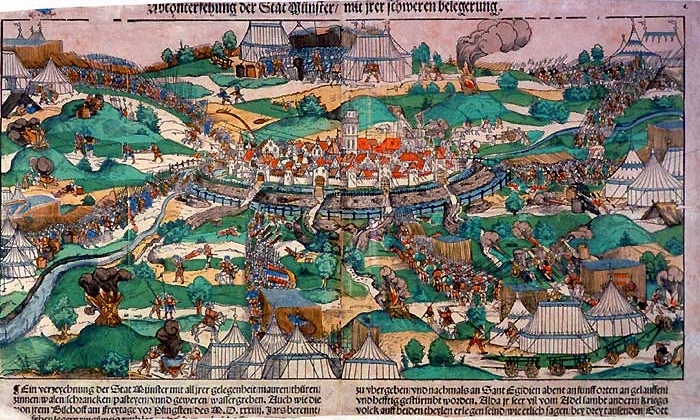
Matthias demanded the execution of all Catholics and Lutherans, warning that “Everywhere we are surrounded by dogs and sorcerers and whores and killers and the godless and all who love lies and commit them!” That was a bit too much even for the crazies, so Catholics and moderate Protestants were expelled from the city. About 2,000 of them, as equal numbers of Anabaptist radicals, poured in from the countryside.
Matthias ordered every contract, account and ledger in town destroyed, in a vain attempt to abolish all debt. Rothmann preached from the pulpit of St. Lambert’s: “Everything that Christian brothers and sisters have belongs to the one as well as to the other.”
Waldeck looked on with increasing alarm and before long, a mercenary army was assembled outside the city walls of Münster. The place was now under siege.
Easter Sunday arrived, April 5, 1534. Jesus, did not. With his apocalyptic prophesy thus shattered, Matthias claimed to have a new, divine vision. He would ride forth from the city walls, and personally break von Waldeck’s siege of the city. So it was that the Anabaptist prophet saddled up and rode forth with an entourage of twelve, only to be run through with a spear, his head mounted on a spike, for all the town to see.
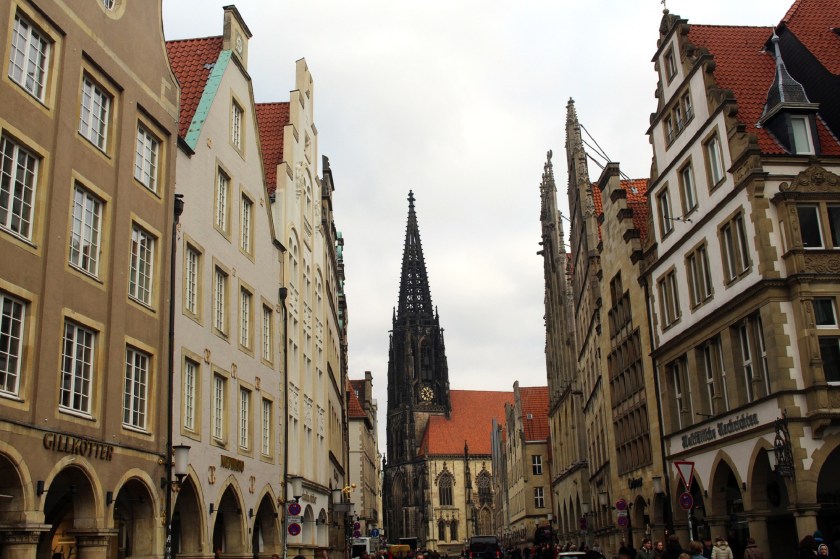
Up stepped the dead prophet’s right-hand man, the charismatic twenty-five year old tailor Jan van Leiden, who delivered a speech reinterpreting the day’s events, and postponing doomsday.
Münster became heavily militarized as Waldeck’s besieging force cut off all access to the city. Jan van Leiden ruled over the city as the new King David, according to his own prophesy. He seemed to think he had a direct line “upstairs” and could conjure up fresh prophesy at a moment’s notice. The seventy-five hundred inhabitants of Münster, believed so as well.
The siege dragged on through 1534 and into the following year. In May 1535, the Anabaptist carpenter Heinrich Gresbeck attempted to escape, only to be caught. In exchange for his life, Gresbeck agreed to show Waldeck a lightly defended gate.
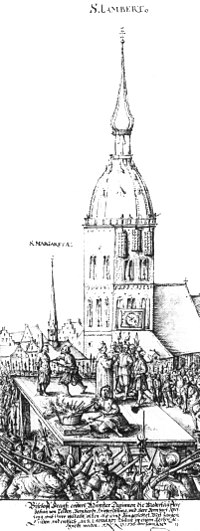
The prince-bishop’s forces fought their way through the streets of Münster on June 25, 1535, killing some 600 Anabaptists before the city surrendered.
Jan van Leiden, “viceroy” Bernhard Knipperdolling and Anabaptist leader Bernhard Krechting were taken to the public square six months later, chained to posts and literally torn to pieces, with white-hot pliers.
Imagine the scene. The sentences encompassed precisely sixty minutes of such treatment. Two executioners and four sets of tongs lest the other two, be out of the coals for too long. Leiden endured an hour of such treatment as first his flesh and then sinew, was torn from his frame. He never made a sound.
Knipperdolling struggled frantically against the spiked collar which held him fast for he knew, he was next. Finally it was Krechting’s turn. Should a man pass out from the agony the clock would be stopped and the prisoner, revived. Then the process would begin, anew. Sixty minutes with those white-hot tongs and not a moment, less.
Finally a dagger was thrust into each man’s heart to end his appointed hour. Their hideously mutilated corpses were placed in cages and hanged from the steeple of St. Lambert’s Church, as a warning to others.
Some fifty years later their bones were removed, but not those cages. In 1880 the old steeple was torn down and a new one built in its place. The cages, were reinstalled.

On November 18, 1944, British bombs hit St. Lambert’s church, knocking the highest cage, van Leiden’s, to the ground. Another fell into the organ loft, leaving the third hanging only, by a thread. The church rebuilt the tower, four years later. Workers repaired and replaced the cages, commenting favorably on their sturdy construction.
Three decades ago, St. Lambert’s church installed a small yellow bulb in each of those cages, a small concession “in memory of their departed souls.” The cages of Münster remain there, to this day.

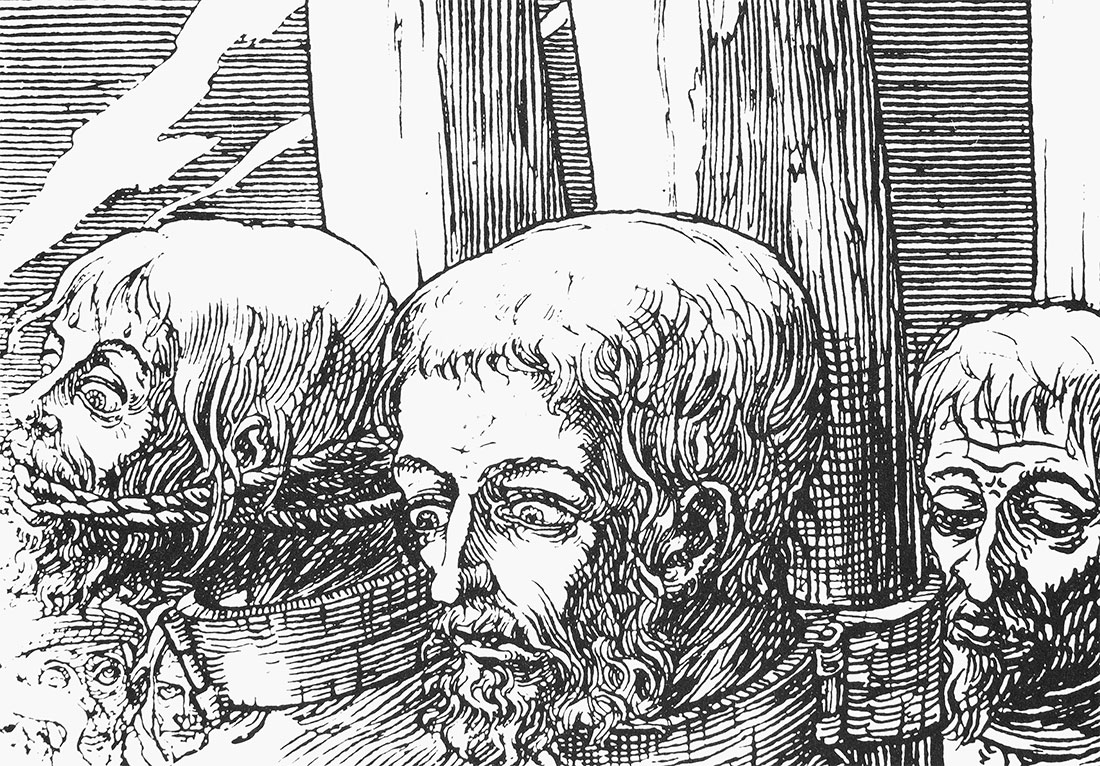

Medieval ‘executions’ were simply barbaric. Who thinks these things up.
LikeLiked by 2 people
That’s a fact, Max. I can’t so much as imagine either inflicting or enduring such treatment.
LikeLiked by 2 people